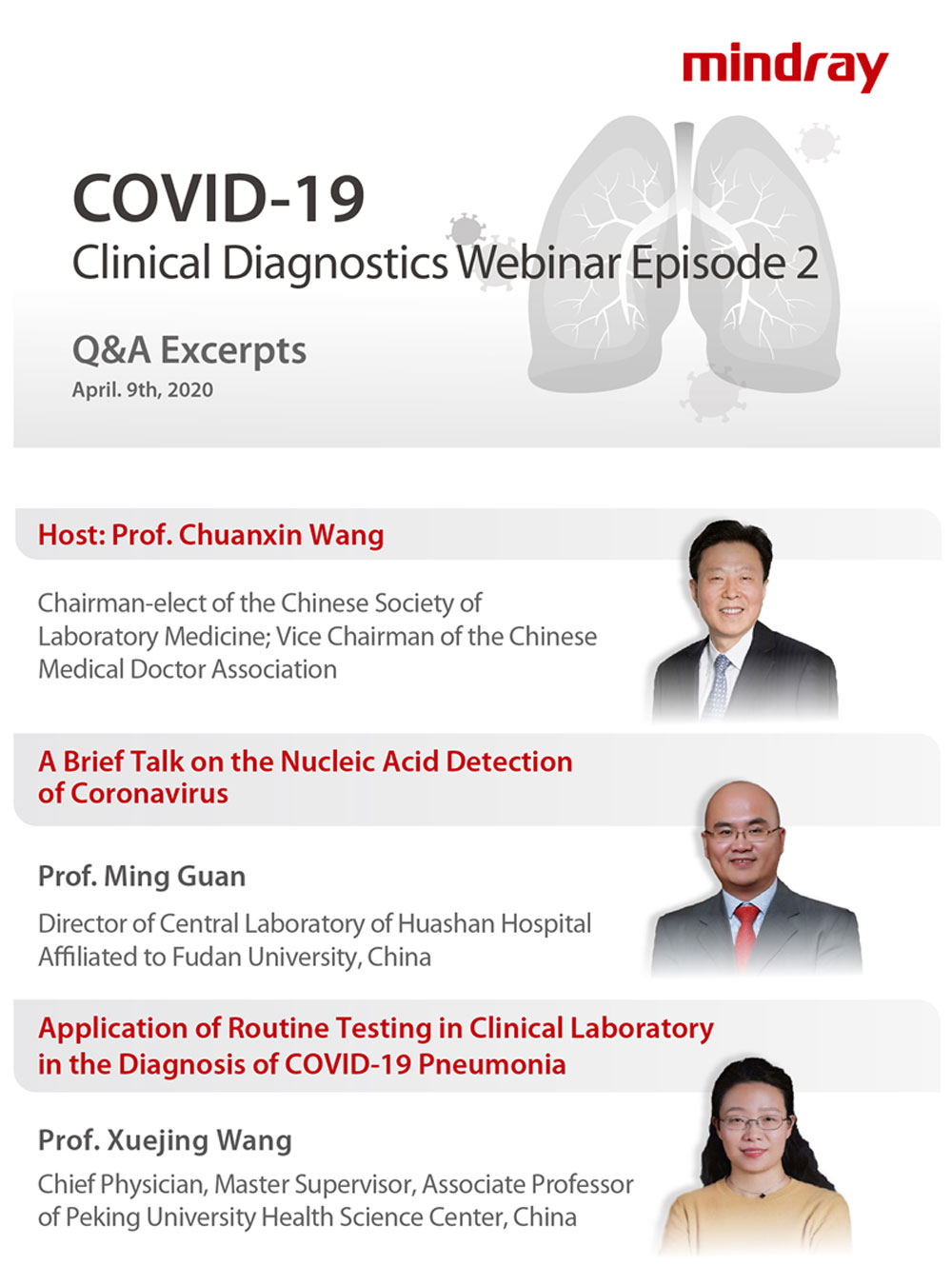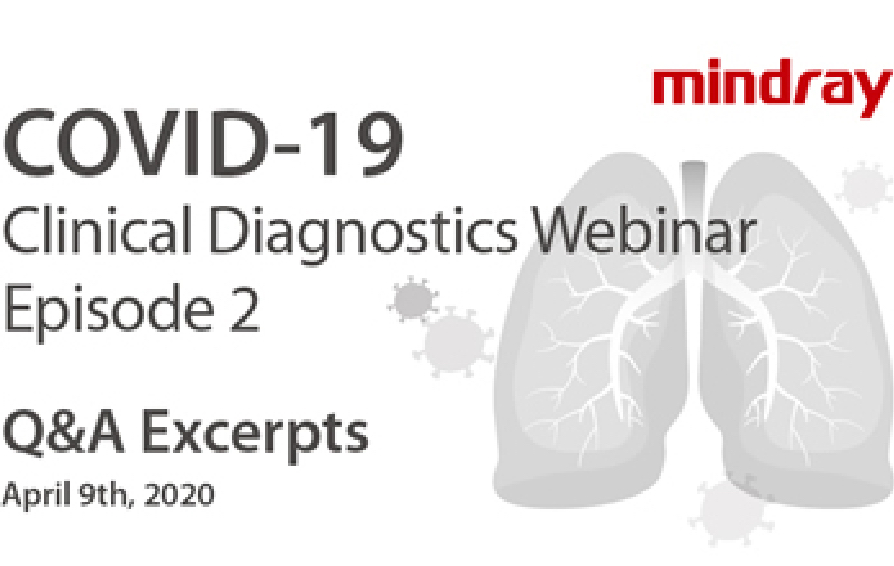
COVID-19 Clinical Diagnostics Webinar Ep2 Q&A Excerpts
Mindray
Prof. Ming Guan: We know that PCR is dependent on the specificity of the primer and the probe to distinguish coronavirus, so you have to prevent the cross reaction and misguided findings, thus the primer and the probe are very important. Regarding domestic tests for novel coronavirus, they target at ORF1ab; the second is the N gene; the third is the E gene. Those are the three areas. They were designed with specific primers. And I've seen other reports that say to target two to three areas on the N gene. We can have those areas as long as they have enough specificity for the nucleic acid to mark the coronavirus. For the sensitivity of PCR, per millilitre we can achieve around 100 copies. That is because the amplification of PCR is very sensitive. And how about the specificity? It will only amplify novel coronavirus, not other viruses. This is guaranteed by the sequence, so you have to have safe and well designed primers so they do not respond or react to other viruses.
Prof. Ming Guan: The antibody is closely related to human immunity. People with high immunity or low immunity have different durations. It can be two to three days at the earliest, or as late as a week. Based on our studies of COVID-19 infection, we have a 40% possibility of finding antibody in the patient in early stage of infection. And for more than 15 days, there’s a 90% to 100% possibility of finding antibody in a patient. So it’s safe to say that, it’s within up to two weeks after onset of symptoms. If you detect for antibody, then you will definitely find antibody in a patient. It may vary from one individual to another, but usually you will find the antibody within two weeks.
The other question is about the significance of the IgG and IgM detection for COVID-19 prognosis. IgG and IgM are very useful for the diagnosis, especially as supplement to nucleic acid testing. If the IgG rises by 4 times, it is very strong evidence for detection of COVID-19. But how about prognosis? This is a very interesting topic. After virus infection, the titer of the antibody detection does matter for the prognosis. We’ve read a report from Xiehe Hospital in Wuhan. It reported 60 cases of COVID-19 patients who were at the time in recovery stages. The patients were tested for antibody titers continuously. It was found that if the patient recovers well, the antibody titer gradually drops. But the sample size is limited, so we have to look for a larger amount of samples. The preliminary conclusion is that antibody detection can be used not only for diagnosis of COVID-19 but also to monitor progress of patient recovery. If the antibody titer is going down, it means the recovery is going well. But the number of patients in the study is limited, so we look forward to our colleagues around the world for further testing of the significance of antibody detection for prognosis.
Prof. Xuejing Wang: In the laboratory setting, in terms of risk management and prevention of the aerosol generation and contamination, we usually run the PCR test, blood test, urine test and fecal test. As we all know, diarrhoea is a common symptom observed in COVID-19 patients. As a matter of fact, the virus can be detected in various fluids. So the key part of risk management, in my opinion, occurs during the procedure when lab technicians are removing the caps of sample containers, such as sputum, swab, whole blood, serum, plasma, urine and fecal matter. For example, RNA extraction, antigen dissolution, and serum specimen transfer after centrifugation, all such operations are pretty risky. And when we dispose the medical waste, we need to pay special attention to safety.
According to our experience, for nucleic acid extraction prior to test, and influenza A and B antigen test with nasal swab specimen, these procedures should be allocated in the biosafety cabinet if possible. For sputum specimen, it is better to be handled in biosafety cabinet as well. For centrifuged blood samples, as the centrifuge cannot be placed in the biosafety cabinet, we recommend that the specimen should be kept still in the centrifuge for at least 15 minutes after centrifugation, and this could prevent aerosol leakage from the specimen. The procedure should be conducted very gently when we remove the cap from the sample container. After the analysis, those finished blood samples should be immediately covered and capped, and the caps should be tightened if you are not using those specimens anymore. All finished samples should be disinfected with proper disinfectant. Steam autoclaving could be applied as this is the best disinfection method in a medical lab.
When we test the feces for COVID-19 patients with diarrhoea, such test should not be in an enclosed environment, and we need to pay more attention to prevent contamination. The main transmission route is from respiratory tracks, while transmission through direct contact is very common. Droplets are often dispersed and could be attached to many kinds of surfaces. So that’s why the common consensus now is that we need to wash our hands frequently. Another reminder, please disinfect all the surfaces when you are going to deal with medical waste, and decontaminate all sample residues before disposal. You can choose hypochlorite to do the surface disinfection. For sample residues, such as the swabs and the remaining liquid, we should add disinfectant into the container and soak for a while before the disposal. These are all key steps to prevent contamination.
Prof. Xuejing Wang: Based on our experience, SARS-CoV-2, the virus that causes COVID-19, is actually more vulnerable than SARS and MERS. So there’s no need to worry, as long as you disinfect your hands, objects and surfaces carefully and frequently. The virus is sensitive to heat and ultraviolet light (UV). It can be inactivated by UV light, heat treatment of 56 degrees C or greater for 30 minutes, 75% ethanol, chlorine-based disinfectant and chloroform. When you use the 75% ethanol to disinfect surfaces, make sure to let it dry naturally. Here’s another reminder: please use the 2g/L chlorine-based disinfectant to disinfect medical waste before disposal.
